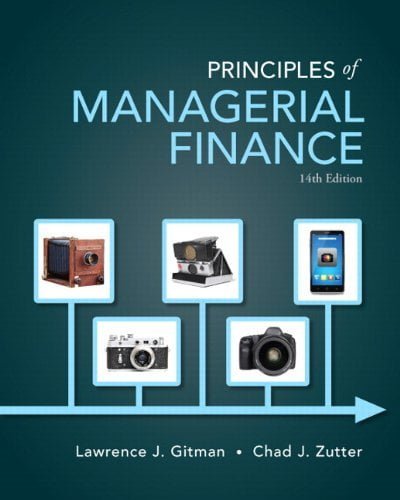This is completed downloadable of Principles of Managerial Finance Gitman 14th Edition Test Bank

Product Details:
- ISBN-10 : 9780133507690
- ISBN-13 : 978-0133507690
- Author:
In Principles of Managerial Finance, Fourteenth Edition, Gitman and Zutter guide you through the complexities of finance with their proven learning system. Teaching and learning aids are woven into concepts and practice, creating a roadmap to follow through the text. Several features–including Why This Chapter Matters and Personal Finance Examples–show the value of applying financial principles and techniques to everyday life.
Table of Content:
PART ONE Introduction to Managerial Finance 1 1 The Role and Environment of Managerial Finance 2 2 Financial Statements and Analysis 40 3 Cash Flow and Financial Planning 95 PART TWO Important Financial Concepts 141 4 Time Value of Money 142 5 Risk and Return 201 6 Interest Rates and Bond Valuation 243 7 Stock Valuation 281 PART THREELong-Term Investment Decisions 321 8 Capital Budgeting Cash Flows 322 9 Capital Budgeting Techniques: Certainty and Risk 361 PART FOURLong-Term Financial Decisions 411 10 The Cost of Capital 412 11 Leverage and Capital Structure 449 12 Dividend Policy 493 PART FIVE Short-Term Financial Decisions 523 13 14 Working Capital and Current AssManagement Current Liabilities Management ets 524 566 AP PENDIXES A B C Financial Tables A-1 Solutions to Self-Test Problems B-1 Answers to Selected End-of-Chapter Problems C-1 Web Chapter: Financial Markets and Institutions on the book's Companion Website www.prenhall.com/gitman Web Chapter: International Managerial Finance on the book's Companion Website www.prenhall.com/gitman Glossary G-1 Index I-1 Contents Preface xxv Revised Content xxviii Supplements to the Twelfth Edition xxxi Acknowledgments xxxiv To the Student xxxvii Part One Introduction to Managerial Finance 1 Chapter 1 The Role and Environment of Managerial Finance 2 1.1Finance and Business 3 What Is Finance? 3 Major Areas and Opportunities in Finance 3 Legal Forms of Business Organization 4 Why Study Managerial Finance? 7 Review Questions 8 1.2 The Managerial Finance Function 8 Organization of the Finance Function 9 Relationship to Economics 9 Relationship to Accounting 10 Primary Activities of the Financial Manager 12 Review Questions 12 1.3Goal of the Firm 13 Maximize Profit? 13 Maximize Shareholder Wealth 14 Corporate Governance 15 The Role of Business Ethics 16 The Agency Issue 17 Review Questions 19 1.4Financial Institutions and Markets 20 Financial Institutions 20 Financial Markets 21 The Relationship between Institutions and Markets 21 The Money Market 21 The Capital Market 22 IN PRACTICE Focus on Practice: Berkshire Hathaway-Can Buffet Be Replaced? 26 Review Questions 27 1.5Business Taxes 27 Ordinary Income 27 Capital Gains 30 Review Questions 30 Summary 30 Self-Test Problem 32 Warm-Up Exercises 32 Problems 34 Chapter 1 Case: Assessing the Goal of Sports Products, Inc. 37 Spreadsheet Exercise 38 Web Exercise 38 xvi CONTENTS Chapter 2 Financial Statements and Analysis 40 2.1 The Stockholders' Report 41 The Letter to Stockholders 41 The Four Key Financial Statements 42 Notes to the Financial Statements 48 IN PRACTICE Focus on Practice: Is It Time to Change SOX? 49 Consolidating International Financial Statements 49 Review Questions 50 2.2 Using Financial Ratios 50 Interested Parties 50 Types of Ratio Comparisons 51 Cautions about Using Ratio Analysis 53 Categories of Financial Ratios 54 Review Questions 54 2.3 Liquidity Ratios 54 Current Ratio 54 Quick (Acid-Test) Ratio 55 Review Question 56 2.4 Activity Ratios 56 Inventory Turnover 56 Average Collection Period 57 Average Payment Period 58 Total Asset Turnover 58 Review Question 59 2.5 Debt Ratios 59 Debt Ratio 60 Times Interest Earned Ratio 61 Chapter 3 Cash Flow and Financial Planning 95 3.1 Analyzing the Firm's Cash Flow 96 Depreciation 96 Developing the Statement of Cash Flows 99 Operating Cash Flow 102 Fixed-Payment Coverage Ratio 61Review Questions 62 2.6 Profitability Ratios 62 Common-Size Income Statements 62 Gross Profit Margin 63 Operating Profit Margin 63 Net Profit Margin 64 Earnings per Share (EPS) 64 Return on Total Assets (ROA) 65 Return on Common Equity (ROE) 65 Review Questions 65 2.7 Market Ratios 66 Price/Earnings (P/E) Ratio 66 Market/Book (M/B) Ratio 66 Review Question 67 2.8 A Complete Ratio Analysis 67 Summarizing All Ratios 67 DuPont System of Analysis 71 Review Questions 74 Summary 74 Self-Test Problems 75 Warm-Up Exercises 76 Problems 78 Chapter 2 Case: Assessing Martin Manufacturing's Current Financial Position 90 Spreadsheet Exercise 92 Web Exercise 94 Free Cash Flow 105 IN PRACTICE Focus on Practice: Free Cash Flow at eBay 106 Review Questions 107 3.2 The Financial Planning Process 107 Long-Term (Strategic) Financial Plans 107 Short-Term (Operating) Financial Plans 108 Review Questions 108 3.3Cash Planning: Cash Budgets 109 The Sales Forecast 109 Preparing the Cash Budget 110 Evaluating the Cash Budget 115 Coping with Uncertainty in the Cash Budget 116 Review Questions 117 3.4Profit Planning: Pro Forma Statements 117 Preceding Year's Financial Statements 118 Sales Forecast 119 Review Question 119 3.5Preparing the Pro Forma Income Statement 119 Considering Types of Costs and Expenses 120 Review Questions 121 CONTENTS xvii 3.6Preparing the Pro Forma Balance Sheet 121 Review Questions 123 3.7Evaluation of Pro Forma Statements 123 Review Questions 124 Summary 124 Self-Test Problems 126 Warm-Up Exercises 128 Problems 128 Chapter 3 Case: Preparing Martin Manufacturing's 2010 Pro Forma Financial Statements 137 Spreadsheet Exercise 138 Web Exercise 139 Part Two Important Financial Concepts 141 Chapter 4 Time Value of Money 4.1 The Role of Time Value in Finance Future Value versus Present Value Computational Tools Basic Patterns of Cash Flow Review Questions 4.2 Single Amounts Future Value of a Single Amount Present Value of a Single Amount 142 143 143 144 146 147 147 147 151 4.4Mixed Streams 160 Future Value of a Mixed Stream 160 Present Value of a Mixed Stream 162 Review Question 164 4.5Compounding Interest More Frequently Than Annually 164 Semiannual Compounding 164 Quarterly Compounding 164 A General Equation for Compounding More Frequently Than Annually 165 Using Computational Tools for Compounding More Frequently Than Annually 167 Continuous Compounding 168 Nominal and Effective Annual Rates of Interest 169 Review Questions 170 4.6Special Applications of Time Value 170 Determining Deposits Needed to Accumulate a Future Sum 170 Loan Amortization 171 Finding Interest or Growth Rates 174 Comparing Present Value and Future Value 153 Review Questions 4.3 Annuities Types of Annuities Finding the Future Value of an Ordinary Annuity Finding the Present Value of an Ordinary Annuity 154 154 155 156 157 Finding the Present Value of a Perpetuity 159 Review Questions 160 xviii CONTENTS IN PRACTICE Focus on Practice: New Century Brings Trouble for Subprime Mortgages 174 Finding Interest or Growth Rates 174 Finding an Unknown Number of Periods 176 Review Questions 178 Summary 178 Self-Test Problems181 Chapter 5 Risk and Return 201 5.1 Risk and Return Fundamentals 202 Risk Defined 202 Return Defined 202 IN PRACTICE Focus on Ethics: What about Moral Risk? 204 Risk Aversion 206 Review Questions 206 5.2 Risk of a Single Asset 206 Risk Assessment 206 Risk Measurement 208 Review Questions 213 5.3 Risk of a Portfolio 213 Correlation 213 Diversification 214 Correlation, Diversification, Risk, and Return 216 Chapter 6 Interest Rates and Bond Valuation 243 6.1 Interest Rates and Required Returns 244 Interest Rate Fundamentals 244 Term Structure of Interest Rates 246 Risk Premiums: Issuer and Issue Characteristics 248 Review Questions 249 Warm-Up Exercises 182 Problems 183 Chapter 4 Case: Funding Jill Moran's Retirement Annuity 198 Spreadsheet Exercise 199 Web Exercise 200 International Diversification 216 Review Questions 218 5.4 Risk and Return: The Capital Asset Pricing Model (CAPM) 218 Types of Risk 218 The Model: CAPM 219 Review Questions 225 Summary 226 Self-Test Problems 228 Warm-Up Exercises 229 Problems 230 Chapter 5 Case: Analyzing Risk and Return on Chargers Products' Investments 240 Spreadsheet Exercise 242 Web Exercise 242 6.2 Corporate Bonds 250 Legal Aspects of Corporate Bonds 250 Cost of Bonds to the Issuer 251 General Features of a Bond Issue 252 Bond Yields 253 Bond Prices 253 IN PRACTICE Focus on Ethics: Can We Trust the Bond Raters? 254 Bond Ratings 254 Popular Types of Bonds 255 International Bond Issues 255 Review Questions 256 6.3 Valuation Fundamentals 257 Key Inputs 258 Basic Valuation Model 259 Review Questions 260 6.4 Bond Valuation 260 Bond Fundamentals 261 Basic Bond Valuation 261 Bond Value Behavior 263 Yield to Maturity (YTM) 266 Semiannual Interest and Bond Values 268 Review Questions 269 Chapter 7 Stock Valuation 281 7.1 Differences between Debt and Equity Capital 282 Voice in Management 282 Claims on Income and Assets 282 Maturity 283 Tax Treatment 283 Review Question 283 7.2 Common and Preferred Stock 283 Common Stock 284 Preferred Stock 287 Issuing Common Stock 289 Interpreting Stock Quotations 293 Review Questions 294 7.3 Common Stock Valuation 295 Market Efficiency 295 Basic Common Stock Valuation Equation 297 Free Cash Flow Valuation Model 299 CONTENTS xix Summary 269 Self-Test Problems 272 Warm-Up Exercises 272 Problems 273 Chapter 6 Case: Evaluating Annie Hegg's Proposed Investment in Atilier Industries Bonds 279 Spreadsheet Exercise 280 Web Exercise 280 Other Approaches to Common Stock Valuation 302 IN PRACTICE Focus on Ethics: Psst-Have You Heard Any Good Quarterly Earnings Forecasts Lately? 304 Review Questions 304 7.4 Decision Making and Common Stock Value 305 Changes in Expected Return 305 Changes in Risk 306 Combined Effect 306 Review Questions 307 Summary 307 Self-Test Problems 310 Warm-Up Exercises 311 Problems 312 Chapter 7 Case: Assessing the Impact of Suarez Manufacturing's Proposed Risky Investment on Its Stock Value 318 Spreadsheet Exercise 319 Web Exercise 320 xx CONTENTS Part Three Long-Term Investment Decisions 321 Chapter 8 Capital Budgeting Cash Flows 322 8.1Capital Budgeting Decision Process 323 Motives for Capital Expenditure 323 Steps in the Process 323 Basic Terminology 325 Review Questions 327 8.2Relevant Cash Flows 327 Major Cash Flow Components 327 Expansion versus Replacement Decisions 328 Sunk Costs and Opportunity Costs 328 International Capital Budgeting and Long-Term Investments 329 IN PRACTICE Focus on Practice: Changes May Influence Future Investments in China 330 Review Questions 331 8.3Finding the Initial Investment 331 Installed Cost of New Asset 331 After-Tax Proceeds from Sale of Old Asset 332 Change in Net Working Capital 334 Calculating the Initial Investment 335 Review Questions 336 Chapter 9 Capital Budgeting Techniques: Certainty and Risk 361 9.1Capital Budgeting Techniques 362 Bennet Company's Relevant Cash Flows 362 Payback Period 363 Net Present Value (NPV) 367 Internal Rate of Return (IRR) 369 Review Questions 371 8.4Finding the Operating Cash Inflows 337 Interpreting the Term After-Tax 337 Interpreting the Term Cash Inflows 337 Interpreting the Term Incremental 340 Review Questions 341 8.5Finding the Terminal Cash Flow 341 Proceeds from Sale of Assets 341 Taxes on Sale of Assets 341 Change in Net Working Capital 342 Review Question 343 8.6Summarizing the Relevant Cash Flows 343 Review Question 345 Summary 345 Self-Test Problems 346 Warm-Up Exercises 347 Problems 348 Chapter 8 Case: Developing Relevant Cash Flows for Clark Upholstery Company's Machine Renewal or Replacement Decision 357 Spreadsheet Exercise 359 Web Exercise 360 9.2Comparing NPV and IRR Techniques 372 Net Present Value Profiles 372 Conflicting Rankings 373 Which Approach Is Better? 374 Review Questions 375 9.3Additional Considerations: Real Options and Capital Rationing 376 Recognizing Real Options 376 Choosing Projects under Capital Rationing 378 Review Questions 380 9.4Behavioral Approaches for Dealing with Risk 380 Scenario Analysis 381 Decision Trees 382 Simulation 383 International Risk Considerations 384 Review Questions 385 9.5Risk-Adjusted Discount Rates 385 Determining Risk-Adjusted Discount Rates (RADRs) 385 Applying RADRs 386 IN PRACTICE Focus on Ethics: Environmental Compliance: Honesty Is the Best Policy 387 CONTENTS xxi RADRs in Practice 389 Review Questions 391 Summary 391 Self-Test Problems 393 Warm-Up Exercises 394 Problems 396 Chapter 9 Case: Making Norwich Tool's Lathe Investment Decision 409 Spreadsheet Exercise 410 Web Exercise 410 Part Four Long-Term Financial Decisions 411 Chapter 10 10.5 Weighted Average Cost The Cost of Capital 412 of Capital 425 Calculating Weighted Average Cost of 10.1Overview of the Cost of Capital 413 Capital (WACC) 425 Some Key Assumptions The Basic Concept Specific Sources of Capital Review Questions 10.2 Cost of Long-Term Debt Net Proceeds Before-Tax Cost of Debt After-Tax Cost of Debt Review Questions 10.3 Cost of Preferred Stock Preferred Stock Dividends Calculating the Cost of Preferred Stock Review Question 10.4 Cost of Common Stock 413 Weighting Schemes 426 413 Review Questions 428 415 415 10.6 Marginal Cost and Investment Decisions 428 416 Weighted Marginal Cost of Capital (WMCC) 428 416 IN PRACTICE Focus on Practice: EVAlue Creation 429 416 Investment Opportunities Schedule (IOS) 432 419 Using the WMCC and IOS to Make Financing/Investment Decisions 432 419 Review Questions 434 420 Summary 434 420 Self-Test Problem 436 420 Warm-Up Exercises 438 421 Problems 438 421 Chapter 10 Case: Making Star Products' Finding the Cost of Common Stock Equity 421 Financing/Investment Decision 445 Cost of Retained Earnings 423 Spreadsheet Exercise 447 Cost of New Issues of Common Stock 423 Web Exercise 448 Review Questions 425 xxii CONTENTS Chapter 11 Leverage and Capital Structure 449 11.1Leverage 450 Breakeven Analysis 451 Operating Leverage 454 IN PRACTICE Focus on Practice: Adobe's Leverage 457 Financial Leverage 458 Total Leverage 461 Review Questions 464 11.2The Firm's Capital Structure 464 Types of Capital 464 External Assessment of Capital Structure 465 Capital Structure of Non-U.S. Firms 466 Capital Structure Theory 467 Optimal Capital Structure 470 Review Questions 472 11.3EBIT-EPS Approach to Capital Structure 472 Presenting a Financing Plan Graphically 473 Comparing Alternative Capital Structures 474 Chapter 12 Dividend Policy 493 12.1Dividend Fundamentals 494 Cash Dividend Payment Procedures 494 Tax Treatment of Dividends 496 Dividend Reinvestment Plans 496 Review Questions 497 12.2Relevance of Dividend Policy 497 Residual Theory of Dividends 497 Arguments for Dividend Irrelevance 499 Arguments for Dividend Relevance 500 Review Questions 501 Considering Risk in EBIT-EPS Analysis 475 Basic Shortcoming of EBIT-EPS Analysis 476 Review Question 477 11.4Choosing the Optimal Capital Structure 477 Linkage 477 Estimating Value 478 Maximizing Value versus Maximizing EPS 479 Some Other Important Considerations 479 Review Questions 480 Summary 481 Self-Test Problems 482 Warm-Up Exercises 484 Problems 484 Chapter 11 Case: Evaluating Tampa Manufacturing's Capital Structure 491 Spreadsheet Exercise 492 Web Exercise 492 12.3Factors Affecting Dividend Policy 501 Legal Constraints 501 Contractual Constraints 502 Internal Constraints 502 Growth Prospects 502 Owner Considerations 503 Market Considerations 503 Review Question 504 12.4Types of Dividend Policies 504 Constant-Payout-Ratio Dividend Policy 504 Regular Dividend Policy 505 Low-Regular-and-Extra Dividend Policy 506 Review Question 506 12.5 Other Forms of Dividends Stock Dividends Stock Splits Stock Repurchases IN PRACTICE Focus on Ethics: Are Buybacks Really a Bargain? Review Questions Summary Self-Test Problem 506 506 508 509 511 512 512 514 CONTENTS xxiii Warm-Up Exercises 514 Problems 515 Chapter 12 Case: Establishing General Access Company's Dividend Policy and Initial Dividend 521 Spreadsheet Exercise 522 Web Exercise 522 Part Five Short-Term Financial Decisions 523 Chapter 13 Working Capital and Current Assets Management 524 13.1Net Working Capital Fundamentals 525 Short-Term Financial Management 525 Net Working Capital 525 The Tradeoff between Profitability and Risk 526 Review Questions 13.2 Cash Conversion Cycle Calculating the Cash Conversion Cycle Funding Requirements of the Cash Conversion Cycle Strategies for Managing the Cash Conversion Cycle Review Questions 13.3 Inventory Management 527 528 528 529 532 532 533 13.4Accounts Receivable Management 538 Credit Selection and Standards 538 Credit Terms 543 Credit Monitoring 545 Review Questions 547 13.5Management of Receipts and Disbursements 548 Float 548 Speeding Up Collections 548 Slowing Down Payments 549 Cash Concentration 549 IN PRACTICE Focus on Ethics: Stretching Accounts Payable-Is It a Good Policy? 500 Zero-Balance Accounts 551 Investing in Marketable Securities 552 Review Questions 553 Summary 553 Self-Test Problems556 Warm-Up Exercises557 Problems 558 Chapter 13 Case: Assessing Roche Publishing Company's Cash Management Efficiency 563 Spreadsheet Exercise 564 Web Exercise565 Differing Viewpoints about Inventory Level 533 Common Techniques for Managing Inventory 533 International Inventory Management 538 Review Questions 538 xxiv CONTENTS Chapter 14 Current Liabilities Management 566 14.1 Spontaneous Liabilities 567 Accounts Payable Management 567 Accruals 571 Review Questions 572 14.2 Unsecured Sources of Short-Term Loans 572 Bank Loans 572 IN PRACTICE Focus on Ethics: Loan Fraud 573 Commercial Paper 578 International Loans 579 Review Questions 580 Appendixes A Financial Tables A-1 B Solutions to Self-Test Problems B-1 C Answers to Selected End-of-Chapter Problems C-1 Glossary G-1 Index I-1
People Also Search:
principles of managerial finance gitman
principles of managerial finance gitman 14th edition
principles of managerial finance gitman 14th edition download scribd
principles of managerial finance gitman 14th edition test bank download pdf





